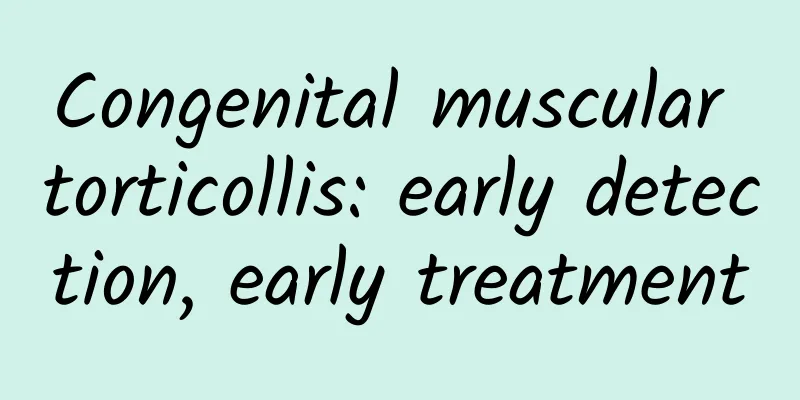Congenital muscular torticollis: early detection, early treatment

|
Congenital muscular torticollis is a congenital deformity. If it is not treated in time, the baby may have head, neck and facial deformities, movement disorders, and abnormal spinal posture. However, if it is discovered early and formal intervention is carried out, most babies will have no obvious sequelae. Congenital muscular torticollis refers to congenital unilateral contracture of the sternocleidomastoid muscle, which leads to asymmetric deformity of the head and neck, with the head tilted to the affected side and the mandible turned to the healthy side. It can be manifested as: 1. Torticollis After the baby is born, parents may find that the baby's head is tilted to the affected side, the face is turned to the healthy side, and the lower jaw is facing the healthy shoulder. Those with mild symptoms need careful observation to find them. Some babies with mild symptoms only have a tilted head, but no sternocleidomastoid muscle mass, muscle tension, or limited passive neck movement. If not intervened in time, this symptom may become increasingly severe as the baby grows and develops. Compensatory scoliosis may occur in the cervical spine. 2. Neck Lump Generally, a neck mass can be felt within 2 weeks after birth. At the same time, the sternocleidomastoid muscle on the affected side is obviously tense, and part of it can be felt in a cord-like shape. The mass is mostly fusiform and painless. 3. Craniofacial deformities Babies may develop plagiocephaly in their early years. If not treated effectively, facial deformities will occur. The main manifestations are asymmetry of the head and face, different sizes of eyes, eyes not on the same level, the healthy side of the face is round and full, and the affected side is narrow and flat. In addition, the baby's entire face, including the nose and ears, may also show asymmetric changes. 4. Limited neck movement 2 to 3 weeks after the baby is born, parents will find that the baby's head always likes to turn to one side, and the range of turning to the other side is limited. For example, the baby always likes to drink milk on one side and is not willing to turn to the other side; he only likes to suck on the hand on one side. The cause of congenital muscular torticollis is still unclear. It may be related to malposition of the fetus in uterus, abnormal embryonic development of the sternocleidomastoid muscle, heredity, sternocleidomastoid muscle hematoma, etc. The "Guidelines for Physical Therapy of Congenital Muscular Torticollis" published in 2018 clearly pointed out that identification and early rehabilitation intervention are the key points of the treatment of congenital muscular torticollis. Here are some tips for parents: 1. Gently touch the baby's neck from behind the ears to the clavicle. Do the neck muscles on both sides feel consistent? Are there any round or fusiform lumps? 2. Observe whether the baby's head shape and face are asymmetrical, and whether the eyes and ears are on the same level? 3. Parents can simply observe at home whether the baby can maintain a symmetrical posture when lying on the back, prone, or upright? 4. Observe whether the range of the baby's head and neck active rotation to both sides is consistent when sleeping, playing and drinking milk? When the baby shows any of the above symptoms, parents need to pay attention and take the baby to the rehabilitation medicine department or pediatric orthopedics department for examination as soon as possible. Neck ultrasound examination is an effective method for diagnosing congenital muscular torticollis and observing the effect of rehabilitation treatment. B-ultrasound is painless, non-destructive, and non-radioactive, so babies can rest assured to undergo the examination. At this time, many parents will ask, why do rehabilitation medicine physicians not only require babies to undergo a neck ultrasound examination, but also recommend adding a hip joint ultrasound examination? This is because congenital muscular torticollis is often associated with developmental hip dysplasia, with an incidence of 7% to 20%. Therefore, it is generally recommended to perform hip ultrasound screening to rule out the presence of hip dysplasia. Babies under 6 months old have acetabulum and femoral head mainly composed of cartilage, so they can be examined by ultrasound to avoid X-rays. Once the diagnosis is confirmed, medical intervention is required as soon as possible. The current treatment methods are mainly rehabilitation and surgery. 01 Rehabilitation For babies under one year old, most of them can get satisfactory results by taking regular rehabilitation treatment. The effect is related to the nature of the mass, the start time of treatment, the frequency of treatment, posture management, etc. Conventional rehabilitation treatment methods include local warm compress, massage, stretching, exercise therapy, posture management, family guidance, etc. Its purpose is to dissipate the mass as soon as possible and prevent muscle fiber contracture. It is recommended that while receiving rehabilitation treatment in the hospital, family rehabilitation treatment can be carried out under the guidance of professional rehabilitation therapists. Such as local moderate massage, adjustment of sleeping position, change of feeding habits, etc. Most babies can be cured through professional rehabilitation treatment. Therefore, once diagnosed, regular rehabilitation treatment should be started as soon as possible. 02 Surgery Babies over 1 year old with torticollis or those who have not achieved satisfactory results after rehabilitation treatment can choose surgical treatment to avoid complications of serious facial deformity, postural strabismus and abnormal cervical spine posture. Neck brace is generally required for postoperative fixation. After the fixation is released, rehabilitation training of neck posture and function can be carried out as needed. The popular science content of this platform has been funded by the China Association for Science and Technology's Science Popularization Department's 2022 National Science Literacy Action Project "National Society Science Popularization Capacity Improvement Project-Rehabilitation Science Popularization Service Capacity Improvement Action Plan" |
>>: Stroke Prevention and Rehabilitation Class
Recommend
What can I apply to prevent stretch marks? What can I apply to prevent stretch marks?
We all know that after a woman becomes pregnant, ...
How long after hysterosalpingography can I have a baby?
Many women go to the hospital for angiography bec...
What are the pathological manifestations of chronic pelvic inflammatory disease?
Pelvic inflammatory disease can actually be divid...
Is ovarian cyst plaster useful?
Ovarian cyst is a disease that women are more lik...
Is it serious if I don't have my period for two months?
If you don't have your period for two months,...
Causes of belly button pain during pregnancy
After many of our female compatriots become pregn...
After menstruation, the lower abdomen also hurts
Women must keep warm during menstruation. It is v...
The girl had been coughing for two months and treated it as a cold. A doctor diagnosed her illness while she was on the subway and found out it was caused by this!
The incident happened on the evening of October 3...
What should I eat if my period is early and there is a lot of blood clots?
Some women sometimes experience early menstruatio...
What to do if you have back pain after having an IUD inserted
The IUD is a very effective contraceptive measure...
Remember these methods of using traditional Chinese medicine to treat thin endometrium!
If a woman's endometrium is relatively thin, ...
What to eat for women with kidney deficiency and back pain
What should women with kidney deficiency and lowe...
Can I take 999 Cold Relief Granules during breastfeeding?
Everyone is familiar with colds and fevers. Many ...
How to clean breasts if you have inverted nipples?
Breasts are one of the important parts of women, ...
Feeling irritable during menstruation
Mature women have their period every month. Due t...









